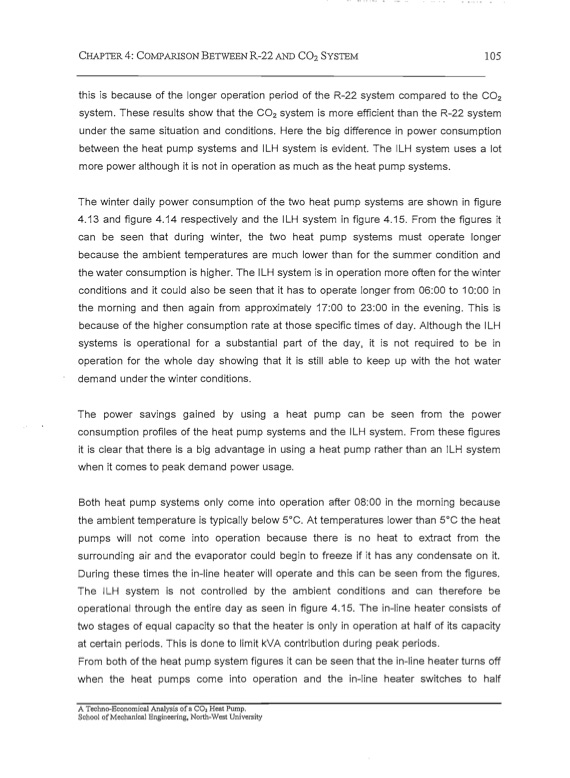
PDF Publication Title:
Text from PDF Page: 117
CHAPTER 4: COMP ARlSON BETWEEN R-22 AND C O 2 SYSTEM 105 this is because of the longer operation period of the R-22 system compared to the CO2 system. These results show that the CO2 system is more efficient than the R-22 system under the same situation and conditions. Here the big difference in power consumption between the heat pump systems and ILH system is evident. The ILH system uses a lot more power although it is not in operation as much as the heat pump systems. The winter daily power consumption of the two heat pump systems are shown in figure 4.13 and figure 4.14 respectively and the ILH system in figure 4.15. From the figures it can be seen that during winter, the two heat pump systems must operate longer because the ambient temperatures are much lower than for the summer condition and the water consumption is higher. The ILH system is in operation more often for the winter conditions and it could also be seen that it has to operate longer from 06:00 to 10:00 in the morning and then again from approximately 17:00 to 23:00 in the evening. This is because of the higher consumption rate at those specific times of day. Although the ILH systems is operational for a substantial part of the day, it is not required to be in operation for the whole day showing that it is still able to keep up with the hot water demand under the winter conditions. The power savings gained by using a heat pump can be seen from the power consumption profiles of the heat pump systems and the ILH system. From these figures it is clear that there is a big advantage in using a heat pump rather than an ILH system when it comes to peak demand power usage. Both heat pump systems only come into operation after 08:00 in the morning because the ambient temperature is typically below 5°C. At temperatures lower than 5°C the heat pumps will not come into operation because there is no heat to extract from the surrounding air and the evaporator could begin to freeze if it has any condensate on it. During these times the in-line heater will operate and this can be seen from the figures. The ILH system is not controlled by the ambient conditions and can therefore be operational through the entire day as seen in figure 4.15. The in-line heater consists of two stages of equal capacity so that the heater is only in operation at half of its capacity at certain periods. This is done to limit kVA contribution during peak periods. From both of the heat pump system figures it can be seen that the in-line heater turns off when the heat pumps come into operation and the in-line heater switches to half A Techno-Economical Analysis of a CO2 Heat Pump. School of Mechanical Engineering, North-West UniversityPDF Image | CO2 HEAT PUMP Analysis

PDF Search Title:
CO2 HEAT PUMP AnalysisOriginal File Name Searched:
co2-heat-pump-techno-analysis.pdfDIY PDF Search: Google It | Yahoo | Bing
CO2 Organic Rankine Cycle Experimenter Platform The supercritical CO2 phase change system is both a heat pump and organic rankine cycle which can be used for those purposes and as a supercritical extractor for advanced subcritical and supercritical extraction technology. Uses include producing nanoparticles, precious metal CO2 extraction, lithium battery recycling, and other applications... More Info
Heat Pumps CO2 ORC Heat Pump System Platform More Info
| CONTACT TEL: 608-238-6001 Email: greg@infinityturbine.com | RSS | AMP |